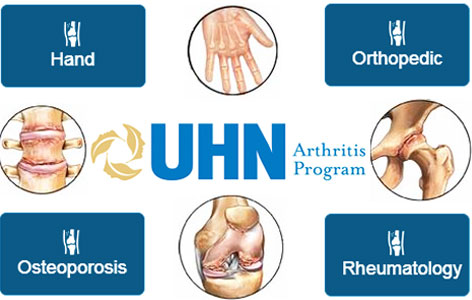
By: Shabana Amanda Ali, UHN Trainee and ORT Times Writer
At UHN, the Arthritis Program represents an interdisciplinary approach to research, clinical care and education with the primary goal of finding a cure for arthritis. It comprises four divisions: Orthopaedic Surgery, Rheumatology, the Hand Program and the Osteoporosis Program. The Arthritis Program is the largest of its kind in Canada, serving over 80,000 outpatients annually. There are over one hundred types of arthritis and several of these are the subject of ongoing research in the Arthritis Program, including osteoarthritis, rheumatoid arthritis, psoriatic arthritis, lupus, ankylosing spondylitis, scleroderma and others. Osteoarthritis is the most common form of arthritis, affecting more Canadians than all other types of arthritis combined. In addition to being complex in terms of etiology and pathophysiology, the condition has evolved over time to be increasingly situated within a biopsychosocial framework.
In 1888, before the availability of X-rays, osteoarthritis was defined clinically based on the following four criteria: cardiac tumult (increased pulse), disseminated pigmentation (freckles or skin blotches), local perspiration and pain1. It was considered a disease of the elderly, caused by degenerative changes that progress with age. There were many commonly held myths about osteoarthritis. For example, it was believed to be an inevitable part of aging and the result of overuse or wear-and-tear. The classic definition of osteoarthritis focused solely on destruction of the cartilage, the connective tissue that lines the ends of the bones in the joints.
With the introduction of X-rays, joint changes could be visualized. The Kellgren-Lawrence grading scale was developed in 1957 to define knee osteoarthritis based on the following four criteria: joint space narrowing, osteophytes (bone spurs), sclerosis and bony deformity2. Using these criteria, patients with knee osteoarthritis could be placed into one of five categories ranging from 0 to 4 with increasing severity. Although this classification remains in wide use today, it is far from perfect, as radiographic features of osteoarthritis do not correlate with symptomatic features. It is not uncommon for a patient to receive a low Kellgren-Lawrence grade but still be experiencing knee pain.
Now in 2018, osteoarthritis is viewed as a total joint disease with psychosocial impacts. In addition to the cartilage, several other joint tissues (e.g., synovium, meniscus, bone, fat pad) undergo pathological changes. It is no longer considered to be only a disease of aging, as joint injury can predispose an individual to post-traumatic osteoarthritis; it is no longer viewed as purely biomechanical, as there is mounting evidence of the critical role of inflammation in osteoarthritis. Furthermore, the chronic pain and compromised joint function can have significant impacts on mood, sleep and overall quality of life. While some risk factors for osteoarthritis are clear (e.g. the female sex), there is still no method to definitively diagnose this disease nor any intervention to halt or reverse its devastating impacts. The strategic priorities of the Arthritis Program are uniquely designed to address these and other outstanding needs in the arthritis field, and progress is being made daily.
References:
1.Spender, J. K. (1888). On some Hitherto Undescribed Symptoms in the Early History of Osteoarthritis: The So-Called Rheumatoid Arthritis. Br Med J, 1(1424), 781-783.
2. Kellgren, J. H., & Lawrence, J. S. (1957). Radiological assessment of osteo-arthrosis. Ann Rheum Dis, 16(4), 494-502.




